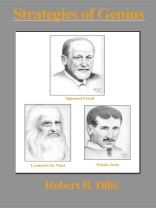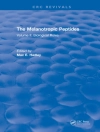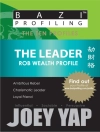Is it possible for mental and even physical healing to take place through the use of language alone? If so, how and why?
What was the basis of Sigmund Freud’s “talking cure” for the symptoms of hysteria and neurosis?
What is the relationship between Freud’s work and modern psychotherapeutic models?
How can his methods help deal with everyday problems or assist people to change limiting beliefs?
What made Leonardo da Vinci such a prolific scientific researcher as well as an exceptional artist?
Is it possible for an average person to be as inventive as Leonardo?
What made it possible for Nikola Tesla to build an entire machine using only his mind’s eye?
How does a person learn to visualize if he or she is not already able to do it naturally?
These questions and many others are explored and answered in this third volume of Strategies of Genius. NLP developer, trainer and author Robert Dilts studies the cognitive strategies of Sigmund Freud, Leonardo da Vinci and Nikola Tesla to uncover unique strategies for healing, change and creativity. This fascinating inquiry into the minds of these three exceptional men unveils the strategies by which they were able to explore and uncover the ‘deeper structures’ of the mind, nature and the future, and in doing so, change our world.
Examine Freud’s strategies for observation, analysis and interpretation by focusing on seemingly trivial details. Investigate Leonardo’s strategies for stimulating his imagination, improving his memory and probing the ‘first principles’ of nature by ‘chunking’ and synthesizing the core elements of a system. Learn how Nikola Tesla developed his ability to visualize to the degree that the only laboratory he needed in order to develop his incredible inventions was the one in his imagination.
By combining the power of NLP with the brilliance and wisdom of some of history’s greatest geniuses and innovators, Dilts is able to model and present simple but effective techniques for changing beliefs and behavior
Innehållsförteckning
Chapter 1 Sigmund Freud: The Search for Deep Structure
Freud’s Epistemology of Mind
Freud’s Analysis of Leonardo da Vinci
Freud’s Analysis of Michelangelo’s Moses
Applications of Freud’s Strategies – Exploring Deeper Structures
The Meta Model
Changing Personal History
Reframing
Reimprinting
Integration of Conflicting Beliefs
Freud and Self-Organization Theory
Self Organization, Sublimation and the ’Swish’ Pattern
The Belief Change Cycle
Strategies of Change Management
Chapter 2 Leonardo da Vinci: Mapping the Microcosm
Knowing How to See
Leonardo’s ‘Cosmography’ of the Body
‘Seeing’ Systemically
Imagination: The Rudder and Bridle of the Senses
Making Machines
Making Masterpieces
Implementing Leonardo’s Strategies
Developing Perceptual Filters
Leonardo’s Strategy for Systemic Thinking and Invention
Chapter 3 Nikola Tesla: Mastering the Mind’s Eye
Envisioning the Future
Developing the Capability to Visualize
Applying Tesla’s Strategy – Creating the Future
Chapter 4 Conclusion: More Patterns of Genius
Om författaren
Robert Dilts has had a global reputation as a leading behavioral skills trainer and business consultant since the late 1970s. A major developer and expert in the field of Neuro-Linguistic Programming (NLP), Robert has provided coaching, consulting and training throughout the world to a wide variety of individuals and organizations.
Robert has pioneered the principles and techniques of Success Factor Modeling TM, and has authored numerous books and articles about how they may be applied to enhance leadership, creativity, communication and team development.
Past corporate clients and sponsors have included Apple Inc., Microsoft, Hewlett-Packard, IBM, The Old Mutual, Société Générale, Bank of America, The World Bank, Alitalia, Telecom Italia, RAI Italia, Lucasfilms Ltd., Ernst & Young, AT Kearney, Salomon, The American Society for Training and Development, EDHEC Business School and the State Railway of Italy. He has lectured extensively on coaching, leadership, organizational learning and change management, making presentations and keynote addresses for The International Coaching Federation (ICF), HEC Paris, The United Nations, The European Forum for Quality Management, The World Health Organization, The Milton H. Erickson Foundation, Harvard University and the International University of Monaco. In 1997 and 1998, Robert supervised the design of Tools for Living, the behavior management portion of the program currently used by Weight Watcher’s International.
Robert was an associate professor at the ISVOR Fiat School of Management for more than fifteen years, helping to develop programs on leadership, innovation, values and systemic thinking. From 2001-2004 he served as chief scientist and Chairman of the Board for ISVOR DILTS Leadership Systems, a joint venture with ISVOR Fiat (the corporate university of the Fiat Group) that delivered a wide range of innovative leadership development programs to large corporations on a global scale.
A co-founder of Dilts Strategy Group, Robert was also founder and CEO of Behavioral Engineering, a company that developed computer software and hardware applications emphasizing learning strategies and behavioral change. He is also co-founder, with Dr. Stephen Gilligan, of the IAGC (International Association for Generative Change). Robert has a degree in Behavioral Technology from the University of California at Santa Cruz.












